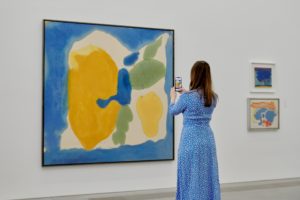Wondering Who Did That Painting? There’s an App (or Two) for That
 With companies racing to develop Shazam for art, we see what instant-identification apps really add to your experience in museums and galleries.
With companies racing to develop Shazam for art, we see what instant-identification apps really add to your experience in museums and galleries.
Magnus is part of a wave of smartphone apps trying to catalog the physical world as a way of providing instantaneous information about songs or clothes or plants or paintings. First came Shazam, an app that allows users to record a few seconds of a song and instantly identifies it. Shazam’s wild success — it boasts more than a billion downloads and 20 million uses daily, and was purchased by Apple for a reported $400 million last year — has spawned endless imitations. There is Shazam for plants or Shazam for clothes and now, Shazam, for art.
The art-oriented apps harness image recognition technology, each with a particular twist. Magnus has built a database of more than 10 million images of art, mostly crowdsourced, and aims to help prospective art buyers navigate the notoriously information-lite arena of galleries and fairs.
Other apps are geared toward museumgoers: Smartify, for example, takes an educational approach, teaming up with museums and sometimes galleries to upload digitized versions of their collections, wall texts, and information about artists. Google Lens — Google’s advanced image recognition technology — is making new forays into the art world. In June, Google Lens announced a partnership with the de Young Museum in San Francisco to show parts of the museum’s collection. In July, Google began collaborating with Wescover, a platform oriented toward design objects, public and local art, furniture, and craft — enabling you to learn the name of that anonymous painting in your WeWork space or coffee shop.
...
Then there is a more salient question for these platforms: What information can an app provide that will enhance the user’s experience of looking at art? What can a Shazam for art really add?
Mr. Resch’s answer is simple: transparency. Galleries rarely post prices and often don’t provide basic wall text, so one often has to ask for the title or even the artist’s name.
...
It’s telling, perhaps, that even as these apps build out their databases, some museums themselves are starting to shy away from apps altogether. The Metropolitan Museum, which rolled out its own app with fanfare in 2014, shuttered it last year.
See the full story here: https://www.nytimes.com/2019/09/11/arts/design/smartphone-art-app.html?
Pages
- About Philip Lelyveld
- Mark and Addie Lelyveld Biographies
- Presentations and articles
- Tufts Alumni Bio